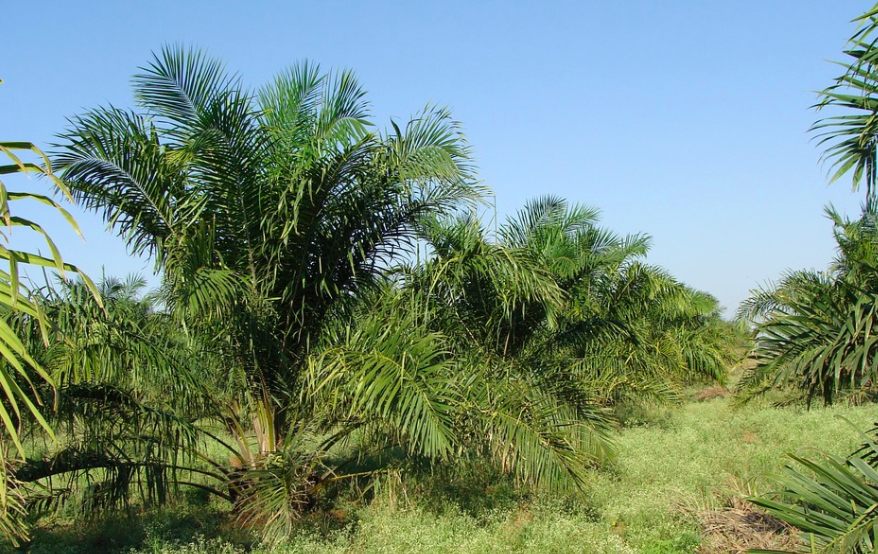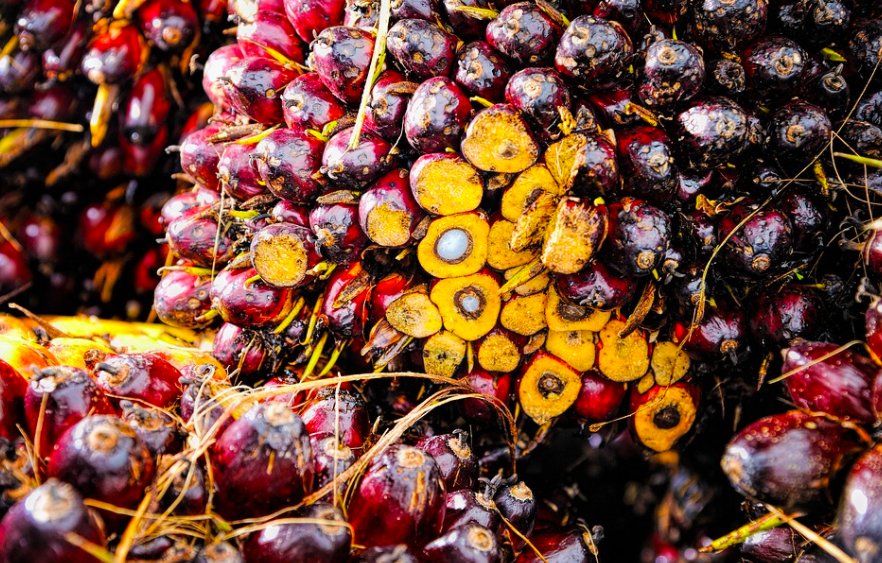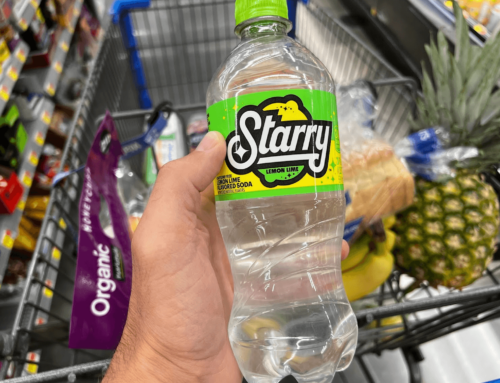Palm oil is a digestible vegetable oil that comes from the fruit of oil palms. The cultivation of palm oil from palm trees has caught the ire of environmentalists who allege the increased demand for the product has encouraged the clearing of certain forest lands vital to the earth’s ecosystem.

A palm oil tree.
Despite environmental claims, palm oil is a beneficial crop. It offers greater yield with minimal production costs compared to other vegetable oils. Currently, palm oil is a $47.2 billion industry and experts have yet to identify any headwinds for the industry in spite of the global pandemic that’s impacted so many industries.
Palm oil can be used as an ingredient in a wide range of consumer products including soap, shampoo, makeup, lip balm, bread, biofuel, potato chips, chocolate, butter, and other foods. Palm oil can also be pressed and used for cooking similar to olive oil. The color of the oil is more of an orange color from that comes from the pulp or kernel of the tree.
Despite the flexibility of the product, many people don’t know what this product is used for. But did you know that over half of American packaged goods contain palm oil? Some of these may be familiar to you such as soap, detergents, lipstick, and even your favorite ice cream.
To get us acquainted with the industry, here are some facts and statistics on the state of the palm oil industry. At the end, share our predictions for the industry for the next five years.
Palm Oil Statistics

A large palm oil tree.
Palm oil is known to be a key ingredient in about 50% of all processed food products, touting numerous health benefits like improved eyesight. (Globe Newswire)
Globally, each person consumes an average of 8kgs of palm oil every year. That converts to about 17.6 pounds per personally annually. Who knew! (The Guardian)
Palm oil supplies 35% of the world’s vegetable oil demand using just 10% of land. (World Wide Fund UK)
Around 3 billion people in over 150 countries use palm oil containing products. This is a widely used product overlooked by many consumers. (The Guardian)
Related Reading: 37 Verified Barbershop Industry Statistics and Growth Trends
Soya, the world’s 2nd largest vegetable oil, occupies 120 million hectares, producing 48 million tons of soya oil. (Green Palm)
Palm oil is generally used as cooking oil in Asian and African countries, much like how sunflower or olive oil is used in the U.S. (World Wide Fund UK)
About 4.5 million people earn some part of their living from palm oil. This includes everyone in the supply chain from shipping companies, farmers, processing companies, and retailers. (Palm Oil Alliance)
75% of the entire palm oil imports to the United Kingdom were viable in 2016. (World Wide Fund UK)
Industry sector palm oil consumption: (International Institute for Sustainable Development). Here’s how palm oil is used.
Processed food industry: 72%
Personal care and cleaning products: 18%
Biofuel industry: 10%
Palm Oil Production Statistics

Many soaps contain palm oil as an ingredient.
Between 1995 and 2015, yearly palm oil production quadrupled, from 15.2 million tons to 62.6 million tons. By 2050, it is anticipated to quadruple again, reaching 240 million tons. This would amount to a staggering 480,000 pounds of palm oil being produced annually. (The Guardian)
Malaysia and Indonesia are the top palm oil producers, accounting for over 80% of the global production. (Grand View Research)
Each palm tree produces about 40 kilograms of palm oil annually while one hectare of oil palm trees can produce 3.8 tons of palm oil every year. (Palm Oil Alliance)
The global palm oil production was approximately 72.27 million metric tons during the marketing year 2019 and 2020, decreasing from about 74.02 million metric tons in 2018 and 2019. (Statista)
Each year, 73 million tons of palm oil is produced. (Palm Oil Alliance)
There were about 17 million hectares of mature palm oil plantations across the equator, producing a total of 62 million tons of palm oil in 2015. (Green Palm)
The demand for palm oil started outpacing supply from 2018 onwards with stocks expected to decrease to close to 8 million tons by 2020. This means production needs to ramp up big time to meet demand. (International Institute for Sustainable Development)
Top palm oil-producing nations Jan – Dec 2015. (Green Palm)
1. Indonesia: 33.4 million tonnes of palm oil
2. Malaysia: 19.9 million tonnes of palm oil
3. Thailand: 1.8 million tonnes of palm oil
4. Colombia: 1.2 million tonnes of palm oil
5. Nigeria: 0.94 million tonnes of palm oil
Approximately 13 million tons or about 21% of the world’s palm oil supply is being certified as responsible and sustainable under the Roundtable on Sustainable Palm Oil (RSPO). (Future Proofed Palm Oil)
Global Palm Oil Statistics

Palm oil is a key ingredient in many makeup products.
The global palm oil market is expected to hit $52.3 billion by the year 2025 with a CAGR of 5%. (Globe Newswire)
The Palm oil industry is also an important contributor to overall economic development, contributing about 4.5% and 2.5% of Malaysia and Indonesia’s GDPs respectively. This business supports many families and farmers. (Future Proofed Palm Oil)
In 2017, the Roundtable on Sustainable Palm Oil (RSPO) certified area planted with palm trees in Indonesia reached 1.7 million hectares, up from 1.54 million hectares in 2016.
The RSPO certified the area planted with palm trees in Indonesia reached 1.7 million hectares In 2017, an increase from 1.54 million hectares the previous year. (Statista)
The APAC region (Asia-Pacific) is the largest market globally with an approximated share of 48% of the total global revenues for 2019. (Globe Newswire)
Market Research: 57 Global Coffee Industry Statistics and Consumption Trends
Crude palm oil (CPO) developed as an important segment of the palm oil market in 2019 making up 58.3% of the total revenue share trailed by palm kernel oil (PKO). (Grand View Research)
In 2017, the average price of palm oil stood at $649 for each metric ton. It is anticipated to surge to about $744 per metric ton by the year 2025, according to the World Bank. (Statista)
The demand for global palm oil was approximated at 74.6 million tons last year and is estimated to register a volume-based CAGR of 2.3% from 2020 to 2027. (Grand View Research)
Palm oil contributes a steady source of income to about 650,000 smallholders in Malaysia and another 3 million in Indonesia. (Future Proofed Palm Oil)
Palm Oil Industry Predictions

Palm oil fruit kernels.
Based on the data, we expect steady industry growth over the next five to ten years. By 2050, experts believe the production of this product could triple. This is an ingredient that has usefulness across many different consumer products making it highly adaptable and less exposed to changes in global consumption habits.
Another safe bet is that organic a sustainably grown palm oil will be in greater demand in the coming years. As we’ve seen with other parts of the food industry, consumers want to buy organic products viewed as healthier and cleaner alternatives. According to the Institute of Food Technologists (IFT), organic food sales in the United States are now over $50 billion with more growth in sight.
As mentioned earlier, palm oil draws criticism from environmental groups as a driver of deforestation. This impacts the habitat of animals like rhinos and pygmy elephants. The practice also impacts the amount of carbon being released into the atmosphere. In the future, we anticipate palm oil producers will find improved ways to grow the crop that doesn’t have a negative impact on the environment. One way this is happening already is through RSPO, a third-party seeking higher standards for the production of palm oil that don’t negatively impact our planet.




